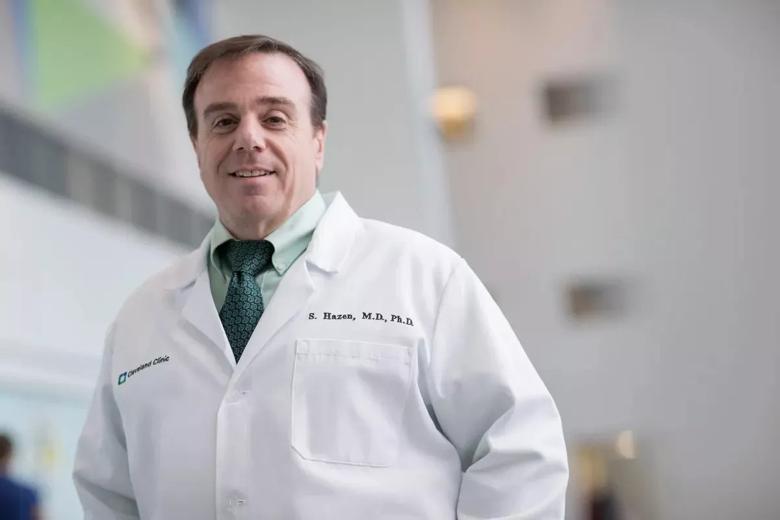Large-scale joint study shows striking link between high blood levels of TMAO and chronic kidney disease risk over time
Content is property of Cleveland Clinic and for news media use only.

New findings from Cleveland Clinic and Tufts University researchers show high blood levels of TMAO (trimethylamine N-oxide) predicts future risk of developing chronic kidney disease over time.
The findings build on more than a decade of research spearheaded by Stanley Hazen, M.D., Ph.D., and a team related to the gut microbiome’s role in cardiovascular health and disease, including the adverse effects of TMAO, a byproduct formed by the gut bacteria from nutrients abundant in red meat, eggs and other animal source foods.
The study, published in the Journal of the American Society of Nephrology, was a collaboration between a Cleveland Clinic research team led by Dr. Hazen and investigators from the Food is Medicine Institute at the Friedman School of Nutrition Science and Policy at Tufts University, including first author Meng Wang, Ph.D., and co-senior author Dariush Mozaffarian, M.D., Dr.PH.
The large-scale study measured blood levels of TMAO over time in two large National Institutes of Health populations and followed the kidney function of more than 10,000 U.S. adults with normal kidney function at baseline over an average follow-up period of 10 years. The investigators found that participants with elevated TMAO blood levels were at increased risk for future development of chronic kidney disease.
Higher TMAO levels were also associated with a faster rate of declining kidney function in people with normal or impaired kidney function at baseline. These associations were independent of sociodemographic characteristics, lifestyle habits, diet and other known risk factors for kidney disease. The findings also are consistent with earlier reported preclinical model studies showing TMAO directly fosters both kidney functional decline and tissue fibrosis.
“The findings indicate a remarkably strong clinical link between elevated TMAO and increased risk for developing chronic kidney disease,” said Dr. Hazen, chair of the Department of Cardiovascular and Metabolic Sciences and at Cleveland Clinic’s Lerner Research Institute and co-section head of Preventive Cardiology in the Heart, Vascular & Thoracic Institute. “The results are from individuals of diverse ethnic and sociodemographic backgrounds who had normal kidney function at the start. The diversity of the participants helps ensure the results are generalizable.”

Chronic kidney disease is a major and growing public health challenge in both the U.S. and globally, affecting about 10-15% of the population worldwide. It also is a strong risk factor for cardiovascular disease. The study showed that TMAO levels were as strong or even stronger an indicator of chronic kidney disease risk than the well-known risk factors such as diabetes, hypertension, advancing age and race.
The study results reinforce the growing body of evidence indicating that lowering TMAO with prescribed drugs could be an effective treatment in patients at risk for, or with early signs of, kidney disease.
“Our study is a crucial complement to studies in preclinical models supporting TMAO as a novel biological risk factor for chronic kidney disease,” said Dr. Wang, research assistant professor at the Friedman School. “TMAO levels are highly modifiable by both lifestyle-like diet and pharmacologic interventions. Besides using novel drugs to lower TMAO in patients, using dietary interventions to lower TMAO in the general population could be a cost-efficient and low-risk preventive strategy for chronic kidney disease development.”
Plans for future studies include examining genetic data to help assess the potential cause-and-effect relationship between TMAO and chronic kidney disease, as well as studying more definitively whether lifestyle changes may prevent chronic kidney disease development and progression.
Dr. Hazen also directs Cleveland Clinic’s Center for Microbiome and Human Health and holds the Jan Bleeksma Chair in Vascular Cell Biology and Atherosclerosis.
This research was supported by grants from the National Institutes of Health, as well as the American Heart Association Postdoctoral Fellowship.
Dr. Hazen is named as co-inventor on pending and issued patents held by Cleveland Clinic relating to cardiovascular diagnostics and therapeutics and has the right to receive royalty payment for inventions or discoveries related to cardiovascular diagnostics or therapeutics.

Cleveland Clinic is a nonprofit multispecialty academic medical center that integrates clinical and hospital care with research and education. Located in Cleveland, Ohio, it was founded in 1921 by four renowned physicians with a vision of providing outstanding patient care based upon the principles of cooperation, compassion and innovation. Cleveland Clinic has pioneered many medical breakthroughs, including coronary artery bypass surgery and the first face transplant in the United States. Cleveland Clinic is consistently recognized in the U.S. and throughout the world for its expertise and care. Among Cleveland Clinic’s 82,600 employees worldwide are more than 5,786 salaried physicians and researchers, and 20,700 registered nurses and advanced practice providers, representing 140 medical specialties and subspecialties. Cleveland Clinic is a 6,728-bed health system that includes a 173-acre main campus near downtown Cleveland, 23 hospitals, 280 outpatient facilities, including locations in northeast Ohio; Florida; Las Vegas, Nevada; Toronto, Canada; Abu Dhabi, UAE; and London, England. In 2024, there were 15.7 million outpatient encounters, 333,000 hospital admissions and observations, and 320,000 surgeries and procedures throughout Cleveland Clinic’s health system. Patients came for treatment from every state and 112 countries. Visit us at clevelandclinic.org. Follow us at x.com/CleClinicNews. News and resources are available at newsroom.clevelandclinic.org.
Editor’s Note: Cleveland Clinic News Service is available to provide broadcast-quality interviews and B-roll upon request.